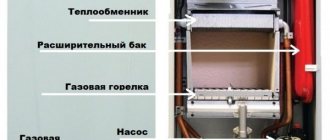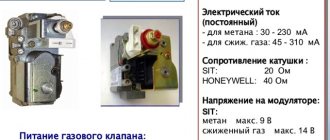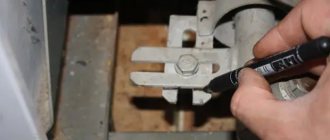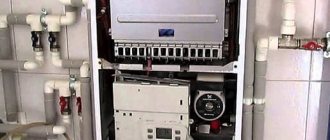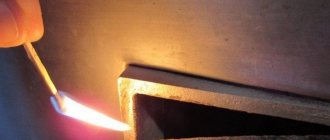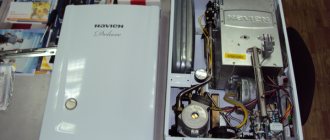Can't find the instructions? Did the recommendations in the brochure not help you? You have the opportunity to read our article about setting up boilers. If you don't know how to handle gas equipment, you need a specialist. But you must admit, it doesn’t hurt to save time and money over and over again thanks to knowledge of the basic settings. Effectively adjusting a gas boiler is much simpler than it might seem.
From the article you will understand the principles of adjusting pressure, thrust and power during operation of the device. Find out the probable causes of problems along with options for eliminating them. If you need to tune the boiler, use our materials. Do not forget about the safety rules, and you will successfully configure the device and fix minor problems.
You should be interested in the settings of a gas boiler long before purchasing, taking into account your needs and various features. We have written which parameters can or should be changed in the device you are using. The new device should be configured and prepared for operation, and some undesirable aspects can be corrected.
How to set up a boiler gas burner?
The gas burner is the heart of any boiler. Important indicators of the unit depend on its adjustment: power and efficiency. Correctly setting the boiler gas burner will save a lot of fuel and will reduce the formation of soot and soot.
- 1 Types of gas burners
- 2 How to set up a gas burner?
- 3 Converting the burner to another type of gas
User manual
I consider the following to be the most dangerous situations when using equipment:
- Gas pressure drop.
- No draft in the chimney pipe.
- Low voltage in the network.
- The igniter went out.
It is necessary to pay attention to such emergency cases, and do not forget about the constant maintenance of the device. Cleaning all elements will not only ensure productive operation, but will also extend the life of the product.
I always advise owners, in addition to setting up the gas boiler, to turn on the heating in the summer at least once every 2 months, then all components of the equipment will not fail at the time of startup in winter and will work as smoothly as possible.
Device
For complete combustion of natural gas and maximum heat transfer, it must be mixed with a certain amount of air with a normal oxygen content, which acts as an oxidizer. At the exit, the fuel mixture of gas and air should burn with a practically colorless flame with a bluish tint and a maximum temperature. By design, gas burners differ in the method of supplying gas and air, mixing components and the method of forming a flame torch.
In household heating boilers, mainly only two types of gas burners are used according to the method of preparing the fuel mixture:
- atmospheric;
- fan (inflatable).
In addition, there are diffusion, injection recuperative, regenerative burners, with preliminary full or partial mixing, but they are in demand mainly in industrial boilers and process equipment. Atmospheric and inflatable types are often improved using certain aspects characteristic of other types of structures, but the principle of operation remains the same.
The type of burner determines the requirements for the design of the combustion chamber, heat exchanger, operational characteristics of the boiler and the method of removing waste gases and exhaust. The last parameter is key for choosing a boiler. For atmospheric burners, a chimney is required to maintain natural draft. For inflatable ones, it is enough to take a special coaxial chimney outside the room.
For heating boilers, it is important to control not only the combustion process as such, but also the output thermal power, because the goal is to heat the coolant and maintain a constant set temperature. This is how the main operational characteristic is determined - the method of power control:
- single stage;
- two-stage;
- with smooth flame adjustment;
- modulation.
Riello single-stage burner
In the first case, the gas burner operates only in one mode of complete combustion of all incoming gas. The main advantage is the simple design and, accordingly, low cost of equipment. However, it is necessary to constantly turn the gas supply on and off in order to maintain the required coolant temperature. The output results in three significant disadvantages: increased gas consumption, strong fluctuations in the temperature of the coolant in the boiler, and a decrease in service life due to frequent switching on/off.
A two-stage power control mode allows the boiler to operate at full power or only at 40-60%. This is achieved by limiting the gas combustion field, actually blocking part of the output nozzles and limiting the volume of incoming gas or by controlling the inlet pressure, reducing or increasing the size of the flame.
Smooth flame adjustment involves adjusting the volume of incoming gas to the entire volume of the gas burner. The size of the flame decreases or increases and, accordingly, the resulting thermal power of the boiler in the range of 40-100%.
Modulation burners actually combine a two- or three-stage method with smooth adjustment. It is possible to limit the combustion field by turning off part of the nozzles, and also to regulate the size of the flame. As a result, in a fully automatic mode, power is adjusted from 10 to 100% while maintaining high efficiency.
Atmospheric
Natural gas is mixed with air directly from the room. The principle of a simple ejector is used. The gas enters specially shaped nozzles inside the burner channel, where outside air has access, and at some distance a series of outlet slots are formed, into which the prepared gas-air mixture enters. In the area from the nozzle to the outlet, a directed gas stream forms a vacuum, constantly drawing air from the outside and mixing with it.
Atmospheric burner operating diagram
The combustion field in the combustion chamber is formed by rows of parallel channels, each of which has a separate nozzle.
After combustion, the heated exhaust rises under the influence of natural draft upward to the heat exchanger, releasing part of the energy, and then into the chimney channel. Due to the difference in air temperature inside the room and in the chimney, draft and air movement are formed, due to which a new portion of oxygen is constantly supplied to the burner.
- simplicity of design, low cost of components;
- energy independence, combustion and its maintenance occurs due to the established process of air circulation and pressure in the gas line;
- simple principle of adjusting output power;
- noiselessness;
- compact dimensions and light weight;
- ease of installation, replacement and maintenance.
- a chimney is required;
- The quality of gas combustion depends on the composition of the air and on the quality of all components of the gas burner and the level of draft, which largely depends on external factors.
Fan
Inflatable gas burners are more complex in design and control, but they provide almost complete automatic control of the combustion process, thermal output and gas consumption. Air for mixing with natural gas is taken from outside the room and forced into the combustion chamber using a powerful fan. By controlling the fan and damper, it is possible to strictly regulate the proportions of gas and air depending on the gas pressure, the operating mode of the boiler and even the composition of the incoming air.
Exhaust and exhaust gases are removed forcibly. There is no need to leave the exhaust too hot to maintain draft, which means more heat is transferred to the coolant, increasing the efficiency of the boiler equipment. A coaxial chimney is used, consisting of two pipes of different diameters, one inserted inside the other. The internal pipe carries the exhaust outside, and in the space between the pipes fresh air enters the burner.
Since the supply of air, gas and their mixing is forced, inflatable gas burners are much easier to design for the use of several types of fuel: gas and liquid fuel (diesel fuel, gasoline, ethyl alcohol and kerosene).
- full control of the preparation of the fuel mixture and combustion;
- wide range of power settings;
- reduction in overall gas consumption;
- increased boiler efficiency;
- possibility of installation in apartments or houses not equipped with a chimney;
- the ability to combine the type of fuel without reworking or reconfiguring the burner and combustion chamber.
- high cost of equipment;
- energy dependence, if there is no electricity, the gas supply is cut off;
- maintenance and operation only with the assistance of specialists.
What's wrong with too much power?
Let's look at setting the power of a gas boiler using the example of a double-circuit device Protherm Gepard 23 MTV. This model is an analogue of the Protherm Panther unit. The same manufacturer that produces Protherm gas appliances produces Vaillant brand boilers in another production facility. Their price is much more expensive, since they use higher quality components. In design and settings, Vaillant gas devices are very similar to Protherm models.
The operating instructions say that the useful thermal power of the Protherm Gepard 23 MTV boiler is adjustable from a maximum of 23.3 kW to a minimum of 8.5 kW. In production, the units are set to a power of 15 kW.
It is good if the heating system to which the gas boiler is connected has a power within the capabilities of the burner device, in our case - from 8.5 to 23.3 kW. But what if the existing radiators require less performance?
For example, let's take an apartment with an area of 50 m². For its heating there are radiators with a thermal power of 4 kW. The installers installed a gas boiler, but did not set the appropriate power. A 4 kW heating system will not be able to accept the installed unit performance of 15 kW. The large difference between the produced and the required indicator makes it impossible to automatically adjust the boiler. Then you need to adjust the device yourself.
Note! Experts categorically do not recommend installing a gas boiler whose power significantly exceeds the required one. This leads to cyclical operation of the unit and its rapid failure.
The characteristics of the gas boiler Protherm Gepard 23 MTV indicate that the efficiency of the device when operating at full thermal power is 93.2%, and at minimum - 79.4%. If the unit operates at a capacity of 4 kW, its efficiency will decrease even more. It turns out that almost a quarter of the thermal energy will “fly down the drain.”
What is a gas boiler power calculator?
How to repair a gas boiler valve with your own hands
What determines gas consumption in gas heating boilers?
Cyclicity of a gas unit and its consequences
Cycling or “clocking” of a gas boiler means that the burner, after being turned on, quickly turns off when the liquid reaches a given temperature in the pipe at the outlet of the unit. But the batteries do not have time to warm up. After a short period, the circulation pump pumps cold water from the heating system into the unit circuit, and the burner turns on again.
Another difficulty lies in the fact that low-power heating pipes have a smaller diameter and higher hydraulic resistance; accordingly, the coolant flows in them more slowly. If you heat the liquid in the heat exchanger with high power, it will reach the set temperature very quickly and the burner will turn off. At the same time, the rest of the water that did not have time to reach the burner will remain cold.
Automation without human intervention will not be able to react to the situation and adjust the optimal power of the device.
Note! With the correct settings of the heating system, the temperature difference between the inlet and return should be no more than 15ºC. Cycling of a gas boiler significantly reduces the service life of the unit and increases fuel consumption
It is known that the components suffer the most wear at the moment of switching on. Also, when ignited, a maximum portion of gas is supplied to the burner, most of which evaporates into the pipe. Frequent re-ignition of the burner further increases fuel consumption and reduces efficiency. To avoid this, it is necessary to adjust the power of the unit, that is, to equalize the performance of the gas boiler and heating system
Cycling of a gas boiler significantly reduces the service life of the unit and increases fuel consumption. It is known that the components suffer the most wear at the moment of switching on. Also, when ignited, a maximum portion of gas is supplied to the burner, most of which evaporates into the pipe. Frequent re-ignition of the burner further increases fuel consumption and reduces efficiency. To avoid this, it is necessary to adjust the power of the unit, that is, to equalize the performance of the gas boiler and heating system.
Setting the gas burner flame
In order to properly configure the burner of a gas boiler, you must first follow the operating instructions for the gas appliance. Next, we’ll talk about how to properly start and set up a gas burner, and in what cases flame adjustment is necessary. But first things first.
Features of boiler burner settings
It is recommended to adjust the burner flame using a gas analyzer. It shows information about the amount of air that is mixed with the gas, namely the level of oxygen involved in the process and the amount of CO.
Typically, CO should be no more than 50 ppm, oxygen concentration should be approximately 3 to 5%. If it is less, then most likely the gas will not have time to burn, as a result of which a lot of soot will accumulate, the CO2 level will be higher than normal, and the efficiency of the equipment will decrease.
If the air is more than normal, then the temperature of the household burner of the gas boiler will be too high, and this can lead to tragic consequences, including an explosion of the equipment.
The flame in the gas burner should be blue. If you find that the color has an orange tint, then try reducing the amount of gas. Reduce until the color turns blue (blue). This color is a sign of optimal operation of the gas appliance. The main thing is not to reduce the fuel supply to the point where the flame becomes almost colorless. In this case, it will go out very quickly.
Setting the starting gas supply is only necessary during ignition and does not affect the performance of the device. But if necessary, it is possible to adjust it too. To begin with, you should reduce the starting fuel supply. Reduce until the burner stops turning on. After this, you can turn the regulator until ignition resumes. You can watch the video at the end of this article for more details on setting the flame of a household gas burner.
We also recommend that you familiarize yourself with the intricacies of adjusting a gas boiler.
When is flame adjustment necessary?
An atmospheric gas burner, which operates without a built-in fan, very often fails; a turbocharged one breaks down much less often. During prolonged use of the device, its components may break or stop working at full capacity.
For example, a gas boiler may experience reduced efficiency or a decrease in flame.
And this can happen for the following reasons:
- High burner power installed for equipment that is designed for less powerful burners. In this case, there is not enough space for proper combustion of fuel, the fuel burns unevenly, which leads to soot quickly accumulating on equipment parts.
- A lot of soot in the chimney can have a bad effect on the draft of a gas boiler. Because of this, the subsequent removal of combustion products is very weak, little air enters, and the flame becomes yellow.
- The presence of burner defects is one of the reasons for reduced boiler efficiency, but in this case, adjusting the flame will not help correct the problem.
- Pressure drops when supplying gas can also contribute to the formation of soot and carbon deposits, and this will significantly reduce the productivity of the equipment.
All these reasons can affect the flame temperature in the gas burner, in which case repairs will be required.
Cleaning the heat exchanger of a double-circuit boiler with your own hands: 5 nuances
In order for the boiler to serve for a long time, it should be cleaned regularly. Cleaning, or as it is also called, washing the heat exchanger of a single-circuit or double-circuit gas boiler at home can be done using chemical or mechanical methods. Similar cleaning is necessary in order to remove all internal deposits that can destroy the metal, and this can lead to disruption of the thermal process in the heating system itself. Then this problem will arise, like the supply of hot water to the main heating system - DHW. As a result, prevention of scale and other deposits is done regularly.
Gas burner device for a boiler
Atmospheric and fan burner devices differ in their structure. This is due to the different ways in which oxygen is supplied to the chamber during fuel combustion.
Atmospheric burner device.
Air enters the combustion chamber directly from the room. Nozzles are located inside the burner channel. Gas is supplied to the nozzles, mixing with air, which also has access here. At a short distance from the nozzles there are outlet slots through which the finished fuel mixture is supplied. An area of reduced pressure is created between the nozzles and outlets, which promotes a constant supply of air for mixing.
A pilot burner is constantly running in the combustion chamber to ignite the main device.
Fan burner device.
The device block consists of:
- engine;
- fan;
- automatic control unit;
- gearbox;
- air pressure switch;
- fuel mixer.
Air is forced from outside by a fan and supplied to the combustion chamber to form a fuel substance. The air to gas ratio can be adjusted using a damper and a fan.
Principle of operation
Water circuits are rarely connected to gas stoves. The room is heated directly by heated air from the stove. The only difference with a solid fuel stove is that natural gas is used, not wood.
Advice. It is very easy to install a water circuit with a heat exchanger or a water tank in gas furnaces; sometimes a system is connected that allows warm air masses to be discharged into adjacent rooms.
There are options for gas stoves combined with a solid fuel unit or powered by electricity. There are universal burners that run on diesel fuel if the need arises.
Important. All installation and repair work related to gas fuel must be carried out exclusively by representatives of a specialized organization that has the appropriate permit.
Selection and configuration of equipment
Issues regarding the operation of the heat supply system of a private home, in contrast to centralized systems, fall entirely on its owners . And one of the problems that has to be solved is the issue of correct selection of gas equipment.
Experience in operating systems shows that a properly selected boiler should operate for at least 30% of the heating period.
The average value of boiler power consumption per square meter of a heated room ( with a ceiling height of up to 3 meters ) is about 100 watts.
Practice also shows that installing a boiler or burner with too high a power can create many problems associated with excessive gas consumption, difficulty in selecting the temperature in heated rooms and the reliability of the system.
After selecting and installing the heating system, as well as each time it is started, the following adjustments are made :
- Complete heating of the boiler.
- Full opening of the chimney damper.
- Setting the burner flame to maximum power (the flame should consist of blue and yellow segments).
- Shut off the gas supply valve when lowering to remove the yellow segment of the flame .
- Checking the safety automation and operating modes of the boiler.
Each season has its own regime
Modern boilers are very easy to adjust a variety of parameters, including the intensity of fuel combustion. This function was introduced for a reason, but to prevent excessive fuel consumption due to clocking. It is recommended to choose your own regime for each season:
- Winter - maximum or average power.
- Spring, autumn - minimum power, in March and November - average.
- Summer - the boiler is not used, or - minimum flame.
However, these settings are relevant if the boiler matches the size of the heated room. Many people take equipment “with a reserve” of power, implying severe frosts, deterioration of the heat-saving properties of housing, or an increase in the area of the premises. In this case, it is recommended to immediately set the flame to minimum, especially if the boiler is wall-mounted.
Burner adjustments may stop working or operate incorrectly over time. If boiler repair is not possible, you can change the flame power using a valve on the gas pipe. This method is rarely used in practice, since valve wear can lead to leaks.
What temperatures do different types produce?
Most burners are now used together with gas cartridges. They are attached to the cans as attachments. Let us consider the main types of such devices in more detail.
- The cheapest household models provide temperatures from 700 to 1000 degrees. A typical representative of such devices can be called tourist burners. They are convenient and can be used to fix a variety of problems. Typically, the fuel mixture in this case is propane and butane.
- More expensive models can heat up to 1200 degrees. A canister filled with liquid natural gas with an ejector burner can raise the temperature to 1600 degrees. Mostly, such devices are used by craftsmen involved in metal processing. Also, devices of this type have high accuracy of adjustable temperature and are able to solder with a clear contour. The majority of such devices are also filled with a mixture of propane and butane. This also includes the so-called collet gas cartridges with burners. They can heat up to 1500 degrees. They got their name because of the method of attaching the burner to the can.
- The highest flame temperature that a gas can can produce is 2400 degrees. The burner cannot raise the heating level to such a value, so this can only be achieved thanks to the special filling of the canister - methyl acetylene propadiene gas. Such torches are used for soldering high-carbon steels and other similar metals. The highest temperature that can be obtained by burning gas on a burner is 3000 degrees. It is achieved by burning acetylene. However, such a mixture is rarely used. Most products do not need such a high temperature to process them. More specifically, it can be noted that the high or low flame temperature during combustion of a mixture is determined by its calorific properties.
Of course, there are other types of burners. In general, it can be noted that primitive products of this kind have a similar design and flame temperature. More expensive models are more equipped and have a higher flame temperature. A device designed for processing metals is a blowtorch. The temperature of its flame, like that of hand-held gas cans, can reach up to 2000 degrees.
Interesting fact. The flame temperature in a regular home burner reaches only 700 degrees. This temperature is achieved due to the fact that the fuel is a gas consisting of 97% methane.
Cutting Features
The cutter must be moved smoothly along the cutting line and monitor the angle of inclination, which deviates 5-6 degrees against the movement of the tool. When the metal thickness is more than 0.95 m, the deflection is increased by cutting through the metal to a depth of about 20 mm, and the deflection angle decreases again. We have already explained in detail how to cut with a cutter so that the cut is even in the previous section.
How much gas is consumed?
Gas consumption when cutting metal with a propane-oxygen cutter depends on the thickness of the structure and the configuration of the cut. For clarity, we present the table below:
| Workpiece size (thickness), mm | Hole time, sec | Cut size (width), mm | Consumption, per m 3 cuts | |
| propane | oxygen | |||
| 4,0 | 5—8 | 2,5 | 0,035 | 0,289 |
| 10,0 | 8—13 | 3,0 | 0,041 | 0,415 |
| 20,0 | 13—18 | 4,0 | 0,051 | 0,623 |
| 40,0 | 22—28 | 4,5 | 0,071 | 1,037 |
| 60,0 | 25—30 | 5,0 | 0,087 | 1,461 |
Gas consumption is significantly reduced when surfacing or soldering is performed.
Nuances
The main task of the performer is to maintain the speed correctly:
- normal mode - sparks fly at right angles relative to the surface of the workpiece;
- low speed - flying away from the performer and an angle of less than 85 degrees.
After the process is completed, the oxygen supply is turned off first, and the propane is turned off last.
[stextbox N. Ishkulov, education: vocational school, specialty: welder of the fifth category, work experience: since 2005: “Performers who perform cutting using oxygen equipment for the first time must remember that they must start a new cut after a sudden stop from a different point, and not where the process was over."
Negative deformation
Beginning welders are concerned with the question of how to properly use a propane-oxygen cutter so that warping of the surface of the part does not occur. First you need to figure out what factors contribute to the occurrence of these defects:
- with uneven heating of the surface;
- a high cutting speed was selected;
- there was a sharp cooling of the heating area.
Adjustment
The cleanliness of the cut depends on the correct flame setting . Oxygen treatment is carried out with a slightly oxidized or normal torch. The carefully adjusted flame of cutters with concentric nozzles is surrounded by a cutting stream of oxygen. The core of the torch in each section should be symmetrical and not differ in brightness.
Cutting with a torch with the mouthpiece moved cannot be carried out, as this will lead to heating of the edge, which will negatively affect the quality of the cut. The use of self-centering mouthpieces increases the ease of use of such equipment, because the device makes the flame symmetrical.
Sometimes the movement of the gas mixture is hampered due to clogging of the channel, which divides the torch into streams and leads to loss of stability. Such a product not only reduces the quality of processing, but also reduces productivity. Flame adjustment is based on creating a symmetrical flame of the required power in relation to the oxygen cutting jet.
A normal flame is ensured with the valves slightly open, which makes it possible to make adjustments during operation. When acetylene and oxygen are fully open, an excessive amount of the former is observed. Smooth closing of the acetylene valve leads to stabilization of the process.
GENERAL OCCUPATIONAL SAFETY REQUIREMENTS
1.1. An employee who is at least 18 years old, who has undergone a medical examination and has no contraindications for health reasons, who has the necessary theoretical and practical training, who has completed introductory and initial workplace safety briefings and training according to a special program, and who is certified, is allowed to perform work using a gas burner. qualification commission and received permission to work independently. 1.2. An employee who performs work using a gas burner (hereinafter referred to as the employee) must periodically, at least once a year, undergo training and testing of knowledge of labor protection requirements and receive permission to perform high-risk work. 1.3. An employee, regardless of qualifications and work experience, must undergo repeated training on labor protection at least once every three months; If an employee violates labor safety requirements, as well as during a break in work for more than 30 calendar days, he must undergo an unscheduled briefing. 1.4. An employee who has not undergone timely instructions and testing of knowledge of labor protection requirements is not allowed to work independently. 1.5. An employee performing work using a gas burner, who is allowed to work independently, must know: safety measures when using gas cylinders and burners. Rules, regulations and instructions for labor protection and fire safety. Rules for the use of primary fire extinguishing agents. Methods of providing first aid in case of accidents. Internal labor regulations of the organization. 1.6. An employee sent to participate in work unusual for his profession must undergo targeted training on the safe performance of the upcoming work. 1.7. An employee is prohibited from using tools, devices and equipment that he has not been trained in the safe handling of. 1.8. When performing work using a gas burner, an employee may be exposed mainly to the following dangerous and harmful production factors: - the possibility of a fire when using a gas burner; — the possibility of a gas cylinder explosion; — gas burner surfaces heated to high temperatures; - uncomfortable working position. 1.9. An employee performing work using a gas burner must be aware that during work, the most likely cause of injury may be burns from the open flame of a gas burner. 1.10. To protect against the effects of dangerous and harmful production factors, the employee must use special clothing, safety shoes and other personal protective equipment. 1.11. To prevent the possibility of a fire, the employee must comply with fire safety requirements himself and prevent other employees from violating these requirements; Smoking is permitted only in designated areas. 1.12. The employee is obliged to comply with labor and production discipline, internal labor regulations; It should be remembered that drinking alcohol usually leads to accidents. 1.13. If an accident occurs with one of the employees, the victim must be given first aid, report the incident to the manager and maintain the situation of the incident, if this does not create a danger to others. 1.14. The employee, if necessary, must be able to provide first aid and use a first aid kit. 1.15. To prevent the possibility of illness, employees should observe personal hygiene rules, including thoroughly washing their hands with soap before eating. 1.16. It is not allowed to perform work while intoxicated or in a state caused by the consumption of narcotic drugs, psychotropic, toxic or other intoxicating substances, as well as drink alcoholic beverages, use narcotic drugs, psychotropic, toxic or other intoxicating substances at the workplace or during work. time. 1.17. An employee who violates or fails to comply with the requirements of labor safety instructions is considered a violator of industrial discipline and may be subject to disciplinary liability, and, depending on the consequences, to criminal liability; if the violation is associated with causing material damage, then the perpetrator may be held financially liable in the prescribed manner.
The situation with Zhytomyr
This brand is famous for its devices with piezo ignition. For an example of burner cleaning, the Zhytomyr 3 model, equipped with EURO SIT technology, is used.
The following list of tools is required for the operation:
- Screwdriver. A flat tip is required.
- Open-end wrenches.
- A regular brush and its analogues for cleaning metal products.
- Yorshik.
After blocking the gas with a key, remove the screw securing the boiler door. It is removed entirely. This way the core of the unit becomes open.
The main burner is concentrated in its lower zone. To remove it and subsequently clean it, you need:
- Disconnect the cable from which the piezoelectric element and electric ignition operate.
- Use a key to remove the thermocouple and its clamp from the valve.
- Mark with a marker the distance of immersion of the nozzle into the burner itself. This will make it easier to return it to the correct position.
- Unscrew the nut securing the valve to the burner. Communication goes through a copper tube.
- Carry out the same manipulations with the ignition electrode.
- Using a screwdriver, remove the two fixing nuts of the other burner (pilot). There is a gasket underneath. If it is damaged or deformed, replace it.
- Remove the nozzle from the burner. If the process is difficult, gently tap around this part with a key.
To dismantle the main burner, the screw connecting it to the boiler body is released. Then it is removed. To do this, you need to grab its lower part and the copper tube and sharply pull it out of the valve.
The screw that fixes the insertion distance of the nozzle part is loosened.
For the cleaning itself, a brush and a brush are used. Carbon deposits are carefully removed.
A vacuum cleaner is used to clean the holes. All work affects both external and internal components.
This algorithm is also suitable for the procedure with the burner of the Dani AOGV series devices, for example -11.5; 23.2 and 29.
You can do the same with many similar units: Aton AOGV 16-EM, ZhMZ-AOGV 17, etc.
The injectors also need to be cleaned. Carbon deposits from the top side are removed with a brush. A wire or thin needle is used to clean the holes.
After this, all the parts are assembled using the reverse algorithm.
Ignition type
All burners can be divided according to the type of ignition:
- Electronic type . They do not have a constantly working igniter. Requires electricity to operate. Electric ignition is one of the most convenient inventions for modern heating units. Thanks to him, the operation of the stoves has become as comfortable as possible. Electric ignition makes it possible to light the burner flame safely, without using available wicks or lighters.
- Burners with piezo ignition . No electricity needed.
Sometimes special working conditions are required, for example, burners are placed in a sauna stove, which must distribute the flame well. These are dividers or ordinary distribution tubes. This is how kitchen gas ovens work.
Flushing
How to clean the heat exchanger of a gas boiler from scale with your own hands? If there is a small amount of plaque inside, you can get by with manual washing using a citric acid solution.
If there is a thick layer of scale, you will need a washing unit that will circulate the detergent for several hours. A 10-liter tank with a pump is suitable for this purpose (you can use a circulation pump from the circuit). Two hoses from the pump are connected to two heat exchanger pipes.
There are three cleaning methods:
- mechanical;
- chemical;
- hydrodynamic.
In the first case, you can use a brush, scraper, or vacuum cleaner to remove plaque. Heat exchanger parts are pre-soaked in cleaning solutions.
During chemical treatment, an acid wash solution is pumped into the system using a booster and driven through a heat exchanger for several hours. Acidic solutions are good at removing ferrous and carbonate sediment. At the end of cleaning, the product is drained and a neutralizing agent is added.
The hydrodynamic method is the injection of water with abrasives into the system under pressure. In this way, the internal surfaces are cleaned mechanically, but the cleaning efficiency is higher than when processed manually. Flushing can be done without dismantling the system, but it is quite expensive. When cleaning yourself, you need to monitor the pressure in the circuits to avoid rupture of the heat exchanger.
Heater Maintenance
Maintenance of an infrared gas heater, like any other equipment, must be carried out at certain intervals. This will help avoid malfunctions during operation of the device.
A large layer of dirt increases thermal insulation, which significantly reduces the effect of heat waves transmitted by the heater into the space being treated. As a result, operating efficiency decreases, which negatively affects the functioning of the unit.
Manufacturers indicate the need and regularity of cleaning in the instructions for the device. This usually needs to be done once a year or as needed. In this case, be sure to turn off the device and wait until it cools down.
Placing the heater in close proximity to a wall may cause the device to overheat and melt plastic parts. Plastic covers heat sensors and causes disruption of thermoregulation. It is necessary to restore not only the housing, but also the sensor
Cleaning is carried out using a damp cloth, which must be soaked in soapy water. This way you can wash the heater body and the location of the cylinder with the gas mixture. Difficult stains can be removed using chemicals and brushes.
Compressed air is usually used to clean the inside of the heater whenever possible. A stream of air should be passed over the surfaces of the burner and ceramic plates until completely clean. The procedure must be carried out carefully so as not to damage the fragile structure of the ceramic parts.
The spark gap and burner openings are also cleaned using compressed air.
After cleaning the device, you need to wipe it dry. The burner and spark gap area must be dry before starting.
It is unacceptable to clean using an abrasive method. Blasting can cause serious damage to the finish of the equipment, resulting in malfunctions
Before reusing the heater again, you need to check the equipment connections for leaks. All connections of the pipeline supplying gas to the device and gas hoses are checked using a soap solution.
If a leak is detected, the device must not be started. Before starting, you must ensure that the leak has been repaired.
Carrying out preventive cleaning of the device and its inspection will help to significantly extend its service life.

